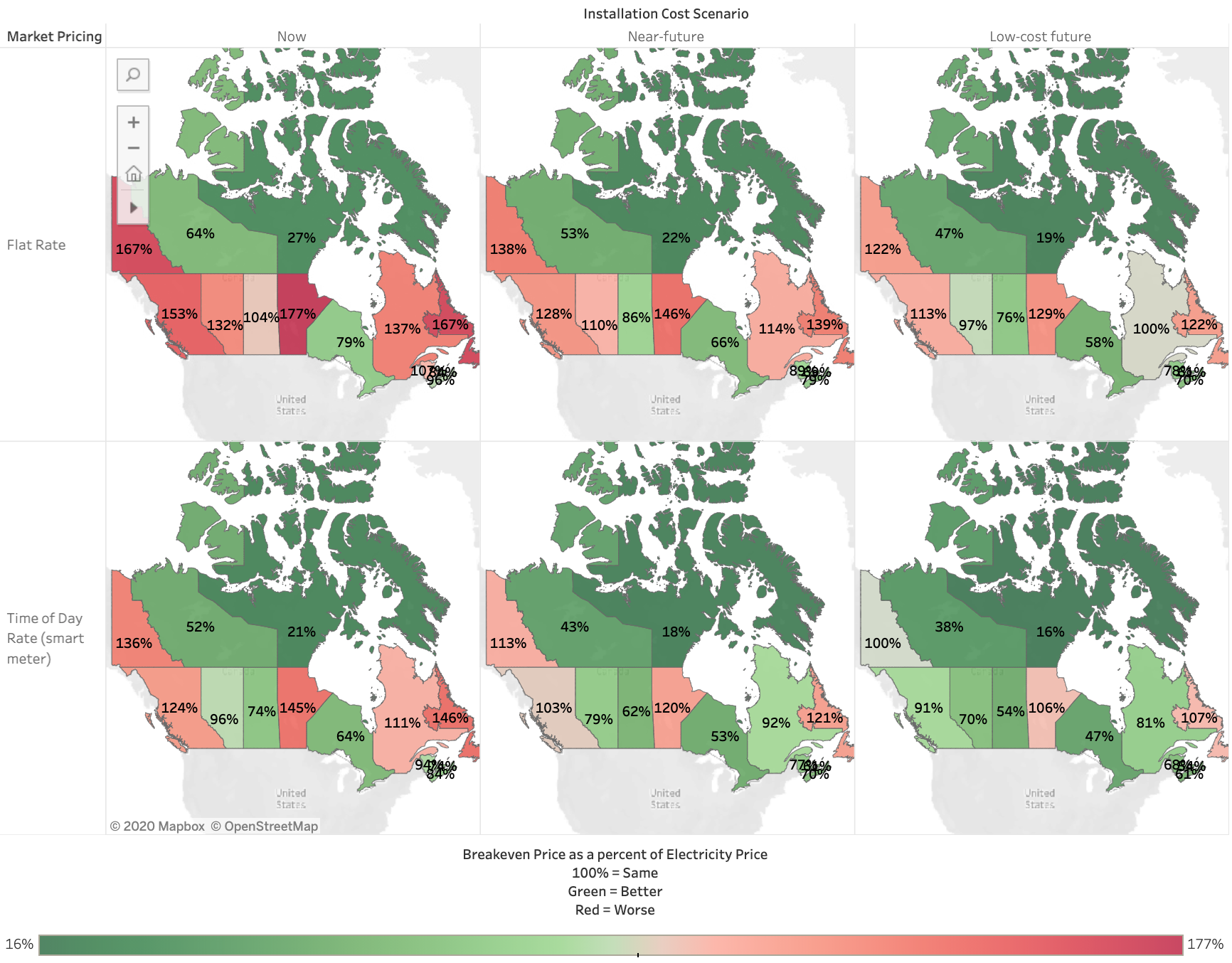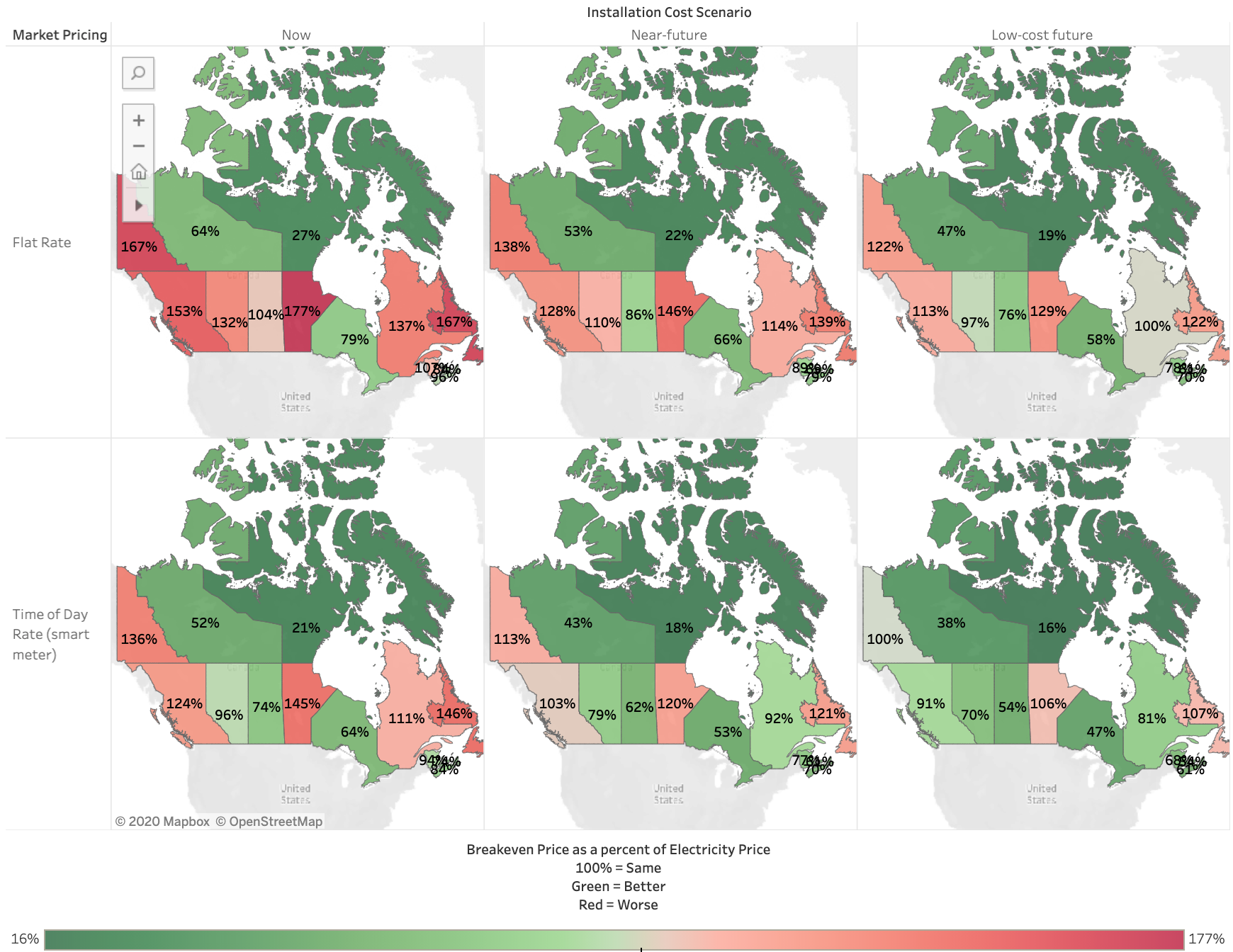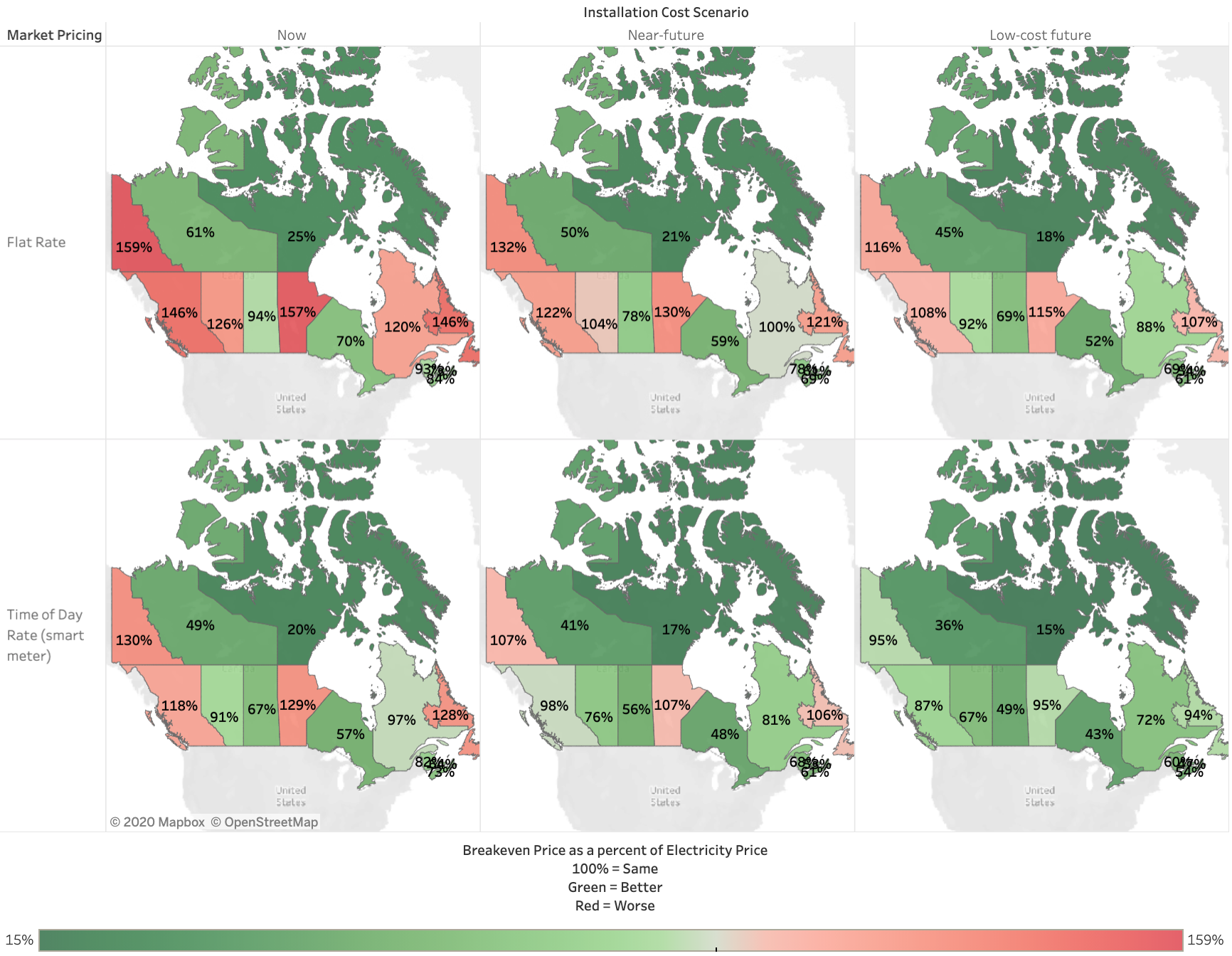The Canada Energy Regulator (formerly the National Energy Board), published a report on the Economics of Solar Power in Canada (ESPC)[1] studying the financial viability of typical solar power projects in over 20,000 Canadian communities. While we’ve spoken quite a bit about the rapid drop in solar costs of the past 10 years, this report helps to give context not only to how far solar has come, but what we can expect in the near future. In many provinces across Canada, it is now cheaper to use solar compared to power from the grid.
The ESPC report estimates the amount and cost of electricity a solar project might generate. That number is then compared to local electricity prices to understand whether it makes financial sense to install solar in that area. Four types of solar projects were considered: commercial, utility-scale, residential and community. These are a few of the key takeaways from the report:
- Smart meters could increase the adoption of residential, commercial, and community solar projects, because they help increase the value of electricity generated during the middle of day and improve solar economics.
- Whether solar generation is competitive in a province or territory often depends more on local electricity prices, rather than the amount of sunlight received.
- Based on assumed installation costs, utility-scale projects with tracking mounts have better economics than utility-scale projects with fixed mounts in Canada.
Making Sense of the Numbers
It is important to note that these numbers are averages that apply to the whole province. Just because solar is cheaper for the majority of the province does not mean you should build a system immediately. Alternatively, just because it is more expensive for most, doesn’t mean that it won’t be cheaper in your particular case.
ESPC estimates solar power economics using three cost scenarios: the cost to install solar now, the cost to install solar in the near future, and the cost to install solar in a low-cost future. This is done because solar installation costs have been falling over the long term and are expected to continue falling. As costs fall in the future, break-even prices will continue falling too.
In the images below, Green means solar generates electricity for less cost than purchasing electricity from a utility. Red means solar generates electricity for more than what it costs to purchase electricity from a utility. Please note that these are average values and individual communities may be higher or lower than the provincial or territorial average.
Commercial Solar
Commercial solar breakevens are currently less than commercial electricity prices in most places in Prince Edward Island, Northwest Territories, Nunavut, Nova Scotia, and Ontario, meaning that most businesses could expect to save money by installing solar. Businesses could also expect to save money with commercial solar in most places in New Brunswick and Yukon if smart meters are installed.

Rebate programs in Saskatchewan make current costs similar to those in the near future, while rebate programs in Alberta make current costs closer to those in a low-cost future. This means businesses could expect to save money with commercial solar in most places in Saskatchewan and Alberta.
In a low-cost future scenario, commercial solar should save businesses money in many Canadian communities.
Residential Solar
Currently, residential solar breakevens are less than residential electricity prices in most places in Prince Edward Island and Saskatchewan, meaning that most homeowners in these areas could expect to save money by installing solar. This is also true for Northwest Territories and Nunavut. However, the cost to install solar in the territories is likely higher than assumed in this study because they are remote.

Many homeowners could also expect to save money with residential solar in Ontario, where homes that have smart meters capture “time of day” value. This is true in some areas of Alberta and Yukon as well.
Rebate programs in Nova Scotia and in Alberta make current costs more similar to those that would occur in a low-cost future. This means residential solar would be expected to save homeowners money almost everywhere in Nova Scotia.
In a low-cost future scenario, residential solar is expected to save homeowners money in many Canadian communities.
Community Solar
Looking at Community Solar costs, the breakevens are similar to the results for Commercial Solar. Community Projects are less than electricity prices in most places in Prince Edward Island, Northwest Territories, Nunavut, Nova Scotia, Ontario, and Saskatchewan, meaning that most communities there could expect to save money by installing solar.

Communities could also expect to save money with solar in many places in Quebec, Yukon and Alberta, if smart meters are installed. Rebate programs in Alberta make current costs similar to prices projected in a low-cost future.This means that today most communities could expect to save money with community solar projects in most places in Alberta.
In a low-cost future scenario, community solar would be expected to save money for most Canadians.
Utility Solar
Provincial tariffs—fees that generators pay for costs like electricity transmission—cause utility scale breakevens to be above electricity prices in all provinces and are therefore uneconomic. If no tariffs are applied (e.g, if the electricity is purchased by a third party who pays the tariffs) Nova Scotia currently has a few locations where breakevens are below electricity prices when earning “time of day” premiums. A few locations in Prince Edward Island require “time of day” premiums and trackers to be installed in order to be economic.
These numbers below show solar breakevens using Tracker mounts, and assuming No Tariffs.
Utility-scale solar in the Northwest Territories and Nunavut have breakevens below electricity prices, meaning they could save consumers money. However, the cost to install solar in the territories could be higher than assumed in this study because they are remote. Utility-scale solar in Yukon might also be economic if generators receive “time of day” premiums.
Costs would have to be lower before some places in Saskatchewan become economic. In a low cost future, many places in Canada become economic, although they would still require no, or lower, tariffs.
Based on assumed installation costs, utility-scale projects with tracking mounts have better economics than utility-scale projects with fixed mounts in Canada. The extra cost to install solar with tracking mounts is more than offset by the increased revenue.
Key Takeaways
The study demonstrates that in many cases it's cheaper to build a solar system and consume the power locally than to purchase power from a Local Distribution Company (LDC). However, the study also shows just how many factors can affect the economics of solar. Even though solar is now the cheapest electricity in history worldwide, the chief factors affecting solar economics are local energy costs, and what government incentives are available.
One important item to note is that these numbers are averages that apply to the whole province. Just because solar is cheaper for the majority of the province does not mean you should build a system immediately. Alternatively, just because solar is more expensive for most, doesn’t mean that it won’t be cheaper for your unique case. There are a wide number of factors unique to you or your business that affect the economics of solar:
- Current power consumption/energy costs - am I using enough power to justify the capital cost of a solar system?
- Building location - Is there a location on my property that is optimal for building a system e.g. an open roof or area unobstructed by trees and other buildings, that is south facing, has the proper azimuth angle etc.
- System design - What’s the proper size of my system so I’m generating enough energy (or making sure I don’t generate too much and waste money). Is it worth it for me to install trackers?
Before starting your journey into solar (or alternatively, writing off solar as too expensive), you really need to run the numbers to see if it makes sense for you. A simple system design or feasibility analysis can help you determine if the economics of a solar system makes sense. An optimal design will be best for your bottom line in the long run, and you can rest easy knowing how long you can expect your system to pay for itself.

Contact us today for a free assessment, we can hep determine if the economics of solar make sense for you.
Sources:
- Government of Canada, N. (2020, September 29). Canada Energy Regulator / Régie de l'énergie du Canada. Retrieved October 29, 2020, from https://www.cer-rec.gc.ca/nrg/sttstc/lctrct/rprt/cnmcsfslrpwr/index-eng.html
- The Economics of Solar Power in Canada. (n.d.). Retrieved October 29, 2020, from https://open.canada.ca/data/en/dataset/7b569daa-59cd-4c14-8ffe-6bc8ebe8d8bb
-
Cost of Solar Power In Canada (Complete Guide 2020). (2020, October 16). Retrieved October 29, 2020, from https://www.energyhub.org/cost-solar-power-canada/

